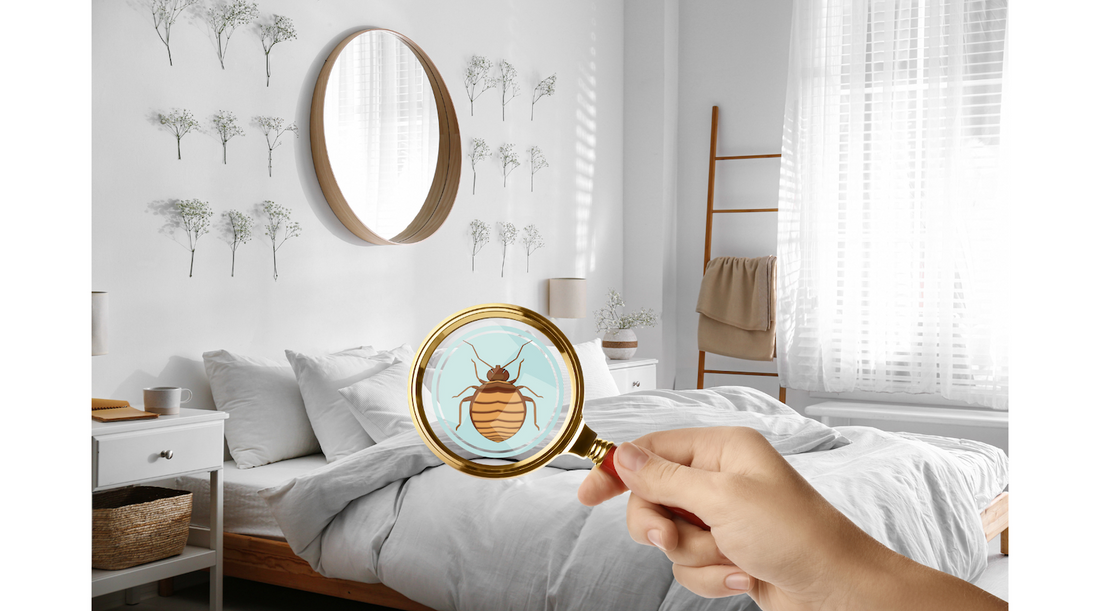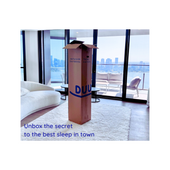When was the last time you thought about the cleanliness of your mattress?
If you're like most people, it's probably not something that crosses your mind often.
Yet, your mattress, a place where you spend most of your life sleeping on, could be a haven for a multitude of unpleasant and potentially harmful things.
From dead skin to dust mites, you may need to rethink changing your mattress especially if you've had it for more than 10 years.
You do not want to sleep on dirt!
Whats inside a mattress?
To understand how dirty a mattress can get, it's crucial to first understand its composition.
Most mattresses are made up of several layers, including:
- Comfort Layer: Usually made of foam, latex, or a combination of both.
- Support Core: Often consisting of springs or high-density foam.
- Fabric Cover: The outer layer that encases the mattress, often quilted and padded for comfort and often not waterproof.
Over time, especially if you sleep without showering, lay in bed without changing from your work clothings or just jump into bed after a long hike - those dirt and germs and would have made its way through your mattress.
Now when you place your body on top of your mattress which you've harbored dirt and germs and accumulated it over the years, imagine sleeping on a pile of dirt.
Now when you wake up itchy or rashes appearing from no where, you need to rethink what you slept on.
Shedding Dead Skin
Human skin constantly regenerates, shedding millions of skin cells each day. On average, a person sheds about 0.5 to 1 gram of dead skin per day.
While that might not seem like much, consider this: over a year, that amounts to roughly 182.5 to 365 grams.
Multiply that by several years, and you have a roughly 4kg of dead skin cells in your mattress.
Dead skin cells serve as a primary food source for dust mites, tiny creatures that thrive in warm, humid environments.
With Australia's ever changing climate, like Melbourne having 4 seasons in a day, your mattress can be the perfect breeding ground for these microscopic pests.
Dust Mites: Unseen Invaders
Dust mites are microscopic arachnids that feed on dead skin cells.
They are invisible to the naked eye but can cause significant problems, especially for people with allergies or asthma.
Here's what you need to know about these tiny invaders:
- Reproduction Rate: A single dust mite can produce up to 100 eggs in its lifetime. Considering the average lifespan of a dust mite is about 2-3 months, populations can grow rapidly.
- Waste Production: Dust mites produce waste pellets, which contain a protein that can trigger allergic reactions. A single dust mite can produce about 20 waste pellets per day. Over the course of a year, a mattress can contain millions of these pellets.
The accumulation of dust mites and their waste can lead to various health issues, including:
- Allergic Reactions: Symptoms such as sneezing, runny nose, itchy eyes, and even asthma attacks can be triggered by dust mite waste.
- Skin Irritations: Prolonged exposure or even a short exposure to dust mites can cause skin conditions like eczema to flare up.
Mould and Mildew: Your worst nightmare
Living in the Australian climate, mattresses are also susceptible to mould and mildew growth.
These fungi thrive in moist environments and can be extremely harmful to your health.
Mould spores can become airborne and cause respiratory issues, especially in individuals with weakened immune systems.
- Humidity: High humidity levels, common in Australia during certain times of the year like in Winter, can lead to increased moisture in your mattress, creating an ideal environment for mould and mildew.
- Health Risks: Exposure to mould can cause symptoms ranging from nasal congestion and throat irritation to more severe reactions like asthma and lung infections.
Bacteria: Unseen Yet Harmful
Bacteria are another unseen threat lurking within your mattress.
Over time, sweat, saliva, and other bodily fluids can seep into your mattress, creating a breeding ground for bacteria.
Some common bacteria that can be found in mattresses include:
- Staphylococcus aureus: This bacterium can cause skin infections, respiratory infections, and even food poisoning.
- Escherichia coli (E. coli): While some strains are harmless, others can cause severe gastrointestinal illness.
- Salmonella: Known for causing food poisoning, salmonella can also be found in contaminated mattresses.
Sweat and Bodily Fluids: Adding to the Mix
It's estimated that an average person sweats about 200 millilitres per night.
Over the course of a year, that's approximately 73 litres of sweat absorbed into your mattress.
Combine this with other bodily fluids like saliva, urine (especially if you have young children or pets), and the occasional accidental spill, and your mattress can become a repository of various liquids.
Bed Bugs: The Nighttime Nuisance
While less common than dust mites, bed bugs are another potential problem.
These small, reddish-brown insects feed on the blood of humans and animals, and their bites can cause itching and discomfort.
Bed bugs are notoriously difficult to eradicate and can hide in the seams and crevices of your mattress.
- Infestation: Bed bugs can quickly multiply and spread to other areas of your home, causing a significant infestation.
- Health Risks: While bed bugs are not known to transmit diseases, their bites can cause allergic reactions and secondary infections from scratching.
Why you should replace your mattress after 10 years
Given all these potential contaminants, it's easy to see why experts recommend replacing your mattress every 7-10 years.
Here are some compelling reasons to adhere to this rule:
- Hygiene: Over time, the accumulation of dead skin, dust mites, bacteria, mould, and bodily fluids can make your mattress a health hazard.
- Comfort: Mattresses lose their support and comfort over time. An old mattress can lead to poor sleep quality, back pain, and other physical discomforts.
- Allergy Prevention: Regularly replacing your mattress can help reduce exposure to allergens like dust mites and mould, leading to better respiratory health.
- Improved Sleep Quality: A new mattress can provide better support and comfort, leading to improved sleep quality and overall well-being.
Tips for Keeping Your Mattress Clean
While replacing your mattress regularly is crucial, there are steps you can take to keep your mattress clean and extend its lifespan:
- Use a Mattress Protector: A high-quality, waterproof mattress protector can prevent spills, sweat, and other fluids from seeping into your mattress.
- Regular Cleaning: Vacuum your mattress regularly to remove dust, dead skin, and other debris. Spot clean stains with a mild detergent and water.
- Air Out Your Mattress: Occasionally air out your mattress by removing bedding and letting it sit in a well-ventilated area. This can help reduce moisture buildup.
- Wash Bedding Frequently: Wash your sheets, pillowcases, and mattress covers regularly in hot water to kill dust mites and bacteria. It is suggested that you should wash your bedding every 2 weeks.
A Clean Mattress Means a Healthier Life
Your mattress plays a vital role in your overall health and well-being.
By understanding the potential hazards lurking in an old mattress and taking proactive steps to keep your mattress clean, you can enjoy better sleep quality and a healthier life.
If your mattress is approaching the 10-year mark, consider investing in a new one.
Not only will you benefit from improved comfort and support, but you'll also be protecting yourself and your loved ones from the hidden dangers of a dirty mattress.
Remember, in Perth's warm climate, these issues can be exacerbated, making it even more crucial to maintain a clean and hygienic sleeping environment.
Don't wait until it's too late—take action today to ensure your mattress remains a safe and comfortable place to rest.
Frequently Asked Questions (FAQ)
Q: How often do I need to clean my mattress?
A: It's best to clean your mattress twice a year to maintain a clean and hygienic sleeping environment.
Regular mattress cleaning helps prevent the accumulation of dust mites, allergens, and other contaminants that can affect your sleep quality and health.
Q: What's the best way to clean a mattress?
A: The best way to clean a mattress involves several steps. First, thoroughly vacuum your mattress to remove surface debris.
Then, spot clean any stains using a mixture of mild dish soap and water or a specialized mattress cleaner.
For deeper cleaning, sprinkle baking soda over the entire surface of the mattress and leave it for several hours before vacuuming it off. This helps absorb odors and freshen the mattress.
Q: How do I clean urine from a mattress?
A: To clean urine from a mattress, start by blotting the area with a clean cloth to absorb as much liquid as possible.
Then, mix equal parts water and white vinegar in a spray bottle and apply it to the affected area.
Let it sit for 15 minutes, then blot dry.
For stubborn stains, you can use a mixture of hydrogen peroxide, dish soap, and baking soda.
Apply this cleaning solution, let it sit, then blot and allow the mattress to air dry completely.
Q: Can I use a steam cleaner on my mattress?
A: While a steam cleaner can be effective for deep cleaning a mattress, it's important to use caution.
Steam cleaning can potentially damage certain types of mattresses, especially memory foam mattresses.
If you decide to use a steam cleaner, ensure your mattress is compatible and follow the manufacturer's instructions carefully.
Always allow the mattress to dry completely before use.
Q: How do I know when it's time to clean my mattress?
A: You need to clean your mattress if you notice visible stains, unpleasant odors, or if you've been experiencing increased allergy symptoms.
Additionally, if it's been more than six months since your last cleaning, it's a good idea to give your mattress some attention.
Regular cleaning helps extend the life of your mattress and ensures a healthier sleeping environment.
Q: What's the best way to maintain a clean mattress between deep cleanings?
A: To maintain a clean mattress between deep cleanings, use a mattress cover as a barrier between your mattress and potential contaminants.
Vacuum your mattress regularly, at least once a month, to remove dust and debris.
Rotate your mattress every three to six months to ensure even wear. Also, address any spills or stains immediately to prevent them from setting in.
Q: Can dust mites really live in my mattress?
A: Yes, dust mites can indeed live in your mattress.
These microscopic creatures thrive in warm, humid environments and feed on dead skin cells.
A dirty mattress can accumulate millions of dust mites over time.
Regular cleaning, including vacuuming and using anti-allergen sprays, can help reduce dust mite populations and minimize allergic reactions.
Q: Is it safe to use cleaning products on my foam mattress?
A: When cleaning a foam mattress, it's important to be cautious with cleaning products.
Harsh chemicals can damage the foam material.
Stick to mild, water-based solutions or products specifically designed for foam mattresses.
Always test any cleaning solution on a small, inconspicuous area first.
For most cleaning needs, a mixture of mild dish soap and water or a solution of equal parts water and white vinegar is safe and effective.

















































